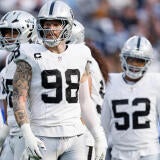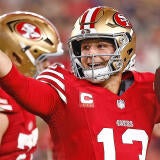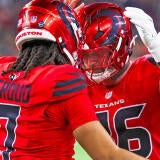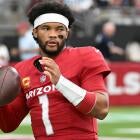NFL offseason: The 7 most improved position groups and 5 most depleted
The Jets are now loaded at CB while the Pats will sure miss Darrelle Revis. The Dolphins and Titans also make big splashes with their pass-catching additions.
With the best free agents off the market and the 2015 NFL Draft in the books, it's time to take a look around the league to assess the most-improved and most-deteriorated position groups.
Most improved position groups
7. Cardinals offensive line
Added: Mike Iupati (FA), D.J. Humphries (Round 1)
Last year, the Cardinals offensive line wasn't the porous abomination it was in 2011 or 2012, yet it was far from a Kevlar wall.
Actually, for the four-man assemblage of Carson Palmer, Ryan Lindley, Drew Stanton and Logan Thomas to only be sacked 28 times on 568 passing attempts was downright impressive.
However, Arizona's ground-efforts screeched to halt.
Not counting quarterback "runs" of any kind, the Cardinals averaged 3.35 yards per carry, the lowest figure in the entire NFL.
What did GM Steve Keim, someone with "Executive of the Year" on his resume, do?
In free agency, he snagged Mike Iupati away from the 49ers, a division nemesis, to play guard. In the first round of the draft, the fleet-footed D.J. Humphries was grabbed to play right tackle.
The addition of those players alone will boost Arizona's rushing attack in 2015, and will help to keep Palmer frequently upright, too.

6. Falcons pass rush
Added: Vic Beasley (Round 1), Adrian Clayborn (FA), Grady Jarret (Round 5), Brooks Reed (FA), O'Brien Schofield (FA)
The Falcons weren't scaring many quarterbacks or taking many to the turf in 2014. Per Pro Football Focus, they registered just 26 sacks and 249 total QB pressures. For intra-division perspective, the Saints had 35 sacks and 264 total pressures. The Panthers? A whopping 41 sacks as part of 274 total pressures. Even the 2-14 Buccaneers had 41 sacks and 226 total pressures.
You didn't have to be GM Thomas Dimitroff or assistant GM Scott Pioli, who now manages scouting and the draft, to realize the pass-rush needed a sizable upgrade.
The signings in free agency of Adrian Clayborn, Brooks Reed and O'Brien Schofield aren't defense-transforming, but they're veterans who'll add situational depth on the Falcons' front seven.
In the draft, Vic Beasley, a springy, Von Miller-clone, fell to Dan Quinn's squadron in Round 1, and someway, somehow, the Geno Atkins-esque Grady Jarrett was available at the beginning of Round 5.
Dimitroff and Co. spent no time trading up to snag the "smaller" but ultra-productive technician.
The Falcons probably won't lead the NFL in sacks or QB pressures in 2015, but the personnel department did admirable work boosting the team's ability to disrupt opposing signal-callers.

5. Ravens pass catchers
Added: Breshad Perriman (Round 1), Maxx Williams (Round 2), Darren Waller (Round 6), Nick Boyle (Round 5)
Lost: Torrey Smith, Owen Daniels
The Ravens couldn't come to terms with speedster Torrey Smith in free agency -- but come on -- we know GM Ozzie Newsome had a master plan.
A younger, more physically imposing Smith was drafted in Round 1 -- Breshad Perriman. The consensus top tight end in the class, Maxx Williams, was snagged in Round 2, and his future tight-end running mate, Nick Boyle, was picked in Round 5.
Darren Waller, a raw, 6-6, 238-pound "receiver" from Georgia Tech was Baltimore's choice in Round 6.
Suddenly, the loss of Smith doesn't sting as much. Neither does the idea that Dennis Pitta may never be the same player due to multiple injuries. In fact, the Ravens pass-catching collection, on paper, is better than it was a season ago.
Well done, Ozzie ... but I wouldn't have expected anything else.
4. Browns defensive front
Added: Danny Shelton (Round 1), Randy Starks (FA), Nate Orchard (Round 2), Xavier Cooper (Round 3)
Mike Pettine doesn't do bad run defenses. Never has stood for them, and he never will. The Jets run-stopping unit was borderline unfair with Pettine on the staff from 2009 to 2011. In 2012, it took a stunning plummet to 21st in the league in yards allowed per carry.
In 2013, Pettine's Bills finished 23rd in yards surrendered per rush. Last year, only three teams were worse than the Browns in the yards given up per carry stat category.
In conjunction with GM Ray Farmer, Pettine's club made a push to add beef and pure talent to its defensive front.
The elder Randy Starks is one of the most underrated defensive tackles in football, and to make room for Ndamukong Suh's historically enormous deal, he wasn't retained by the Dolphins.
In the opening round of the draft, Danny Shelton, a considerably wide nose tackle with unfathomable movement skills for his stature, was Cleveland's pick.
After that, versatile edge-rusher Nate Orchard was selected to back up -- and potentially push -- Barkevious Mingo.
The Browns weren't done bolstering their defense. In Round 3, Xavier Cooper, a penetrating defensive tackle, was grabbed.
No doubt about it -- Cleveland's defense will be more formidable in the trenches in 2015.
3. Titans receivers Added: Dorial Green-Beckham (Round 2), Harry Douglas (FA), Hakeem Nicks (FA), Tre McBride (Round 7)
When you watch the Titans offense, one player stands out above the rest -- Kendall Wright. Beyond him though, and maybe Delanie Walker, Tennessee's attack is bland and far from intimidating.
With Marcus Mariota in the mix and skilled pocket passer Zach Mettenberger heading into Year 2, the Titans knew they had to bring in receiving weapons.
Harry Douglas was a reliable No. 3 target in Atlanta behind Julio Jones and Roddy White. Hakeem Nicks' finest days are behind him, but there aren't many teams with a better No. 4 or even No. 5 wideout.
Dorial Green-Beckham has the natural ability, that, if cultivated, will land him somewhere in the range of Brandon Marshall and Calvin Johnson. And don't ask me why William and Mary's Tre McBride, a 6-foot circus-catch specialist, fell to Round 7. He was too tempting to pass up at that juncture.
The Titans receiving crop is certainly more threatening now than it was just a few months ago.

2. Dolphins pass catchers
Added: DeVante Parker (Round 1), Kenny Stills (Trade), Jordan Cameron (FA), Greg Jennings (FA)
Lost: Mike Wallace, Brian Hartline, Charles Clay
Dolphins GM Dennis Hickey totally transformed his team's pass-catching group in one offseason. And, boy did it ever need an overhaul.
Mike Wallace was traded away, and in a separate swap, a younger, more well-rounded version of Wallace was acquired in Kenny Stills.
Miami braced for the loss of multidimensional talent Charles Clay by signing seam-splitting tight end Jordan Cameron.
Greg Jennings, who still has "it" and was inexplicably on the market more than two months after free agency opened, was signed in April.
In the draft, DeVante Parker, who has some Josh Gordon and A.J. Green to his game, was snatched up in Round 1 when he slipped all the way to the Dolphins' selection.
No excuses for fourth-year quarterback Ryan Tannehill this season.
1. Jets cornerbacks
Added: Darrelle Revis (FA), Antonio Cromartie (FA), Buster Skrine (FA) Antonio Allen, Darrin Walls, Kyle Wilson -- the Jets top cornerbacks on November 1, 2014.
Now, Gang Green can trot out Darrelle Revis, Antonio Cromartie and slide Buster Skrine into the slot.
Quite the difference.
New York will have the oldest outside cornerback tandem in the NFL this season, but Revis (30) is still an elite man-to-man cover guy, and Cromartie (31) experienced a somewhat surprising resurgence a year ago with the Cardinals under new Jets head coach Todd Bowles.
In 2013 with the Jets, Cromartie allowed an abysmal 19.1 yards per catch and was scorched for seven touchdowns.
In 2014 under Bowles' tutelage, receivers averaged 14.6 yards per reception and scored only twice on Cromartie.
No specific positional group in the league made a more significant jump this offseason than the Jets cornerbacks.
Most Deteriorated
5. Cowboys running backs
Lost: DeMarco Murray
Added: Darren McFadden (FA)
Sure, much of DeMarco Murray's incredibly productive 2014 campaign was due to the Cowboys' steam-rolling offensive line and sheer volume.
But accumulating 1,800-plus yards at 4.7 yards per carry doesn't just happen if you're a lackluster running back talent.
What's ironic is Dallas inked the large and majorly-talented Darren McFadden to replace Murray, but the former Raiders' bell cow, though not yet 28, is not nearly as explosive as he once was and much more of a linear athlete than anything else.
It was surprising the Cowboys didn't add to their backfield in this year's draft which featured a super-deep class of running backs.
Yes, the door has been swung wide open for Joseph Randle, but losing Murray and only adding McFadden makes for noticeable deterioration on the ground in Big D.
4. Saints pass catchers
Lost: Jimmy Graham, Kenny Stills
Added: None
The Saints were smart to make a hefty investment in their offensive line -- protecting Drew Brees remains priority No. 1.
But in the process of making said investment, elite tight end Jimmy Graham and rocket Kenny Stills were shipped away.
In the draft, with a clear need for an injection of pass-catching skill, New Orleans did not use any of its nine selections on a receiver or tight end, although the defense absolutely had to be addressed.
In fairness, 2014 first-round pick Brandin Cooks is coming off an injury, and there are intriguing yet inexperienced talents at wideout like Brandon Coleman, Seantavius Jones and Nick Toon.
In the end though, the Saints got considerably worse at tight end and receiver this off-season.
3. Ravens defensive line Lost: Haloti Ngata, Pernell McPhee
Added: Carl Davis (Round 3)
Iowa's Carl Davis stands 6-5 and weighs just north of 320 pounds. His burst off the snap usually gives him the upper hand on offensive lineman, and he's strong enough to take on blocks, shed them and take down running backs.
But to say he'll wholly replace Haloti Ngata would be putting unfair expectations on the rookie.
Also, Pernell McPhee, a career overachiever who could play any spot on Baltimore's defensive front, deservedly signed a lucrative deal with the Bears in free agency.
Fourth-round pick Za'Darius Smith has the size and strength to set the edge, but he's not as refined as McPhee, and though he has upside, it'll take him a while to become an adequate stand-in for the veteran.
It'll be interesting to see how the typically resilient Ravens respond to the departures of Ngata and McPhee.
2. 49ers inside linebackers
Lost: Patrick Willis (Retired), Chris Borland (Retired)
Added: Philip Wheeler (FA)
No more Patrick Willis or Chris Borland for the 49ers. Yikes.
Both complete inside linebackers called it quits this off-season, and the 49ers front office decided not to address the position in the draft. The lone addition at inside linebacker was Dolphins castoff Philip Wheeler, and San Francisco is his fourth NFL team, which should tell you something.
We mustn't forget -- NaVorro Bowman, who, to many, had surpassed Willis in many key linebacking areas, is set to return to the field for the 49ers in 2015.
Losing Willis and Borland can't be understated, though.
Willis could eventually end up in the Hall of Fame, and Borland was as impactful as any inside linebacker as a rookie last season.
1. Patriots cornerbacks Lost: Darrelle Revis, Brandon Browner, Kyle Arrington (released but not still available), Alfonzo Dennard
Added: Bradley Fletcher (FA), Darryl Roberts (Round 7)
Losing Darrelle Revis is a mega hit to the New England defensive backfield. Add in the losses of Brandon Browner, Kyle Arrington and Alfonzo Dennard and, man, it's going to be outrageously difficult for the Patriots to even match 50 percent of the lockdown ability their secondary showed during their Super Bowl-winning season.
Bradley Fletcher was picked on often in Philadelphia, and although Round 7 pick Darryl Roberts has impressive ball skills and athleticism, he's making a big jump from Marshall to the NFL.
The Patriots may have a better pass-rush in 2015, but their secondary has deteriorated more than any other positional group in football.
















